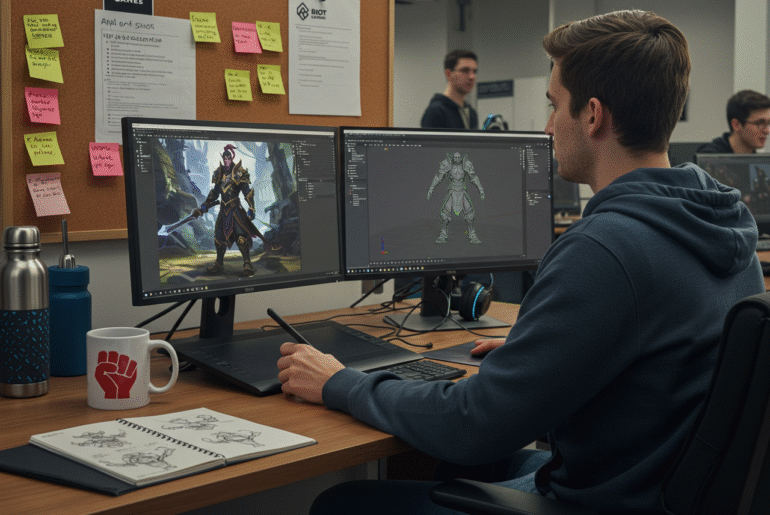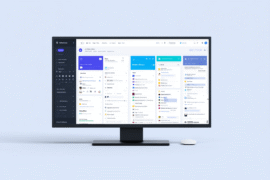This article may contain references to products or services from one or more of our advertisers or partners. We may receive compensation when you click on links to those products or services. Nonetheless, our opinions are our own.
The information presented in this article is accurate to the best of our knowledge at the time of publication. However, information is subject to change, and no guarantees are made about the continued accuracy or completeness of this content after its publication date.
- Highlights
- Internship Roles in Video Game Art
- Role of a Video Game Artist Intern
- Responsibilities in a Studio Setting
- Types of Video Game Art Specializations
- Core Skills Every Beginner Should Develop
- Digital Art Fundamentals
- Collaboration and Communication in Game Development
- How to Start a Career as a Video Game Artist
- Resources You Will Need
- Preparing for a Video Game Artist Internship
- Final Thoughts
- Frequently Asked Questions
- Recommended Reads
Highlights
- Video game artist internships let you work in game design and development studios. You get to help with real projects.
- Interns get hands-on practice by working right in the middle of game creation and designing what people play.
- There are several main paths you can go into, like 3D art, animation, and user interface design. This gives you lots of career options.
- Important skills, like being good at digital art and working with others, are must-haves if you want to make it in this field.
- Getting ready for these internships means you need to make a strong showcase of your work, learn software that is often used in the business, and meet new people in the industry.
- These internships also let you learn from teachers or mentors so that you can get better at making games.
Internship Roles in Video Game Art
Going for a video game artist internship is a big step if you love gaming and creating. These roles let you work with experienced professionals and help you understand how games are made. You might design characters or help with gameplay visuals, giving you the chance to contribute to real projects.
Role of a Video Game Artist Intern
A video game artist intern helps bring creative ideas to life in the form of visual game elements. Interns work with development teams to design visuals that players interact with. This includes animations, textures, and game environments.
By trying different art tasks across game types, interns develop both technical and creative skills. Success in this role requires creativity, adaptability, and a strong interest in digital art and games.
Responsibilities in a Studio Setting
Interns assist with game visuals by creating 3D models, textures, and animations. These elements shape the look and feel of the game. Working on a variety of tasks helps interns improve their skills while learning from experienced professionals.
Interns also help design environments, characters, and user interface components. These elements support the game narrative and improve the player experience. Art and design are combined in an interactive way.
Studio collaboration is key. Interns often work with developers, designers, and other creatives. Good communication and teamwork help resolve visual challenges and enhance the final game product.
Types of Video Game Art Specializations
Video game art includes several specialization paths. Each focuses on a different aspect of game visuals and design.
| Specialization | Description |
|---|---|
| 3D Modeling | Creating three-dimensional assets like characters, objects, and landscapes. |
| Animation | Designing and animating sequences that bring characters and environments to life. |
| Concept Art | Sketching characters or worlds to shape a game’s initial visual direction. |
| User Interface Design | Designing in-game menus, icons, and navigation systems for smooth user interaction. |
| Environment Design | Developing detailed settings that support gameplay and enhance atmosphere. |
Each path offers unique skill-building opportunities and lets you contribute to immersive game worlds.
Voted "Best Overall Budgeting App" by Forbes and WSJ
Monarch Money helps you budget, track spending, set goals, and plan your financial future—all in one app.
Get 50% OFF your first year with code MONARCHVIP
Core Skills Every Beginner Should Develop
To succeed as a video game artist, beginners should focus on building these core skills:
- Game Design Principles: Understand spatial design and player engagement techniques.
- Adaptability: Stay current with new tools, trends, and workflows.
- Creative Problem-Solving: Collaborate effectively to solve design challenges.
These skills help you work efficiently in a studio setting and leave a positive impression on peers and mentors.
Digital Art Fundamentals
Mastering digital art is important for video game development. Key concepts include:
- Color Theory: Sets mood and tone for game environments.
- Layer Management: Organizes artwork for easier edits and adjustments.
- Lighting Techniques: Directs player focus and adds emotional depth.
- Digital Brushes: Provides stylistic variety and texture.
These fundamentals ensure your art fits well with the game’s design goals and enhances player experience.
Collaboration and Communication in Game Development
Interns must communicate clearly and collaborate with teams that include coders, designers, and producers. Strong teamwork supports both creative freedom and production goals.
Effective communication includes expressing ideas clearly and responding to feedback constructively. Visual aids like mock-ups can help convey complex concepts.
Being open to feedback promotes personal growth and builds professional relationships that may lead to future job opportunities.
How to Start a Career as a Video Game Artist
Getting started in game art involves learning basic skills and understanding studio processes. Follow these steps:
- Use beginner-friendly platforms such as Unreal Engine tutorials.
- Practice with structured, hands-on design projects.
- Explore creativity through characters, environments, and animation.
Staying consistent and curious helps build confidence and a strong creative portfolio.
Resources You Will Need
To thrive in a studio environment, you need the right tools:
- Graphics Tablets: Ideal for sketching and detailed digital work.
- Software: Adobe Photoshop and Blender are widely used for 2D and 3D design.
- Learning Platforms: Unreal Engine offers structured learning for beginners.
- Portfolio Website: Showcases your best work for employers and peers.
- Networking Communities: Discord and IGDA provide valuable industry connections.
Familiarity with these tools prepares you for real-world tasks and fosters creativity.
Preparing for a Video Game Artist Internship
1. Build Your Art Portfolio
Your portfolio is your visual résumé. Include 6 to 10 strong pieces that showcase your range, characters, environments, textures, etc. Use finished work and include solo and collaborative projects.
Label each piece with short descriptions of your role and contribution. A clean, organized portfolio helps you stand out.
2. Learn Industry Software
Proficiency with tools like Unreal Engine, Maya, and Photoshop is necessary. Start with beginner tutorials, then move on to more advanced techniques.
Apply what you learn in small, completed projects to demonstrate competence and readiness for a studio setting.
3. Practice with Realistic Projects
Work on projects that mimic real studio assignments. Examples include:
- Creating a playable demo level.
- Designing an environment based on a narrative theme.
- Matching character animations to gameplay mechanics.
These exercises improve workflow knowledge and enhance both technical and creative skills.
4. Network and Apply for Internships
Join online communities and attend industry events to connect with professionals.
- Engage with Discord groups and IGDA chapters.
- Attend conferences to showcase your work and build relationships.
- Use LinkedIn to follow recruiters and share your portfolio.
Tailor your résumé and cover letter for each internship. Focus on relevant skills and experience. Strategic networking improves your chances of landing an opportunity.
Final Thoughts
To succeed as a video game artist intern, focus on building skills in game design, adaptability, and creative problem-solving. A strong, diverse portfolio of 6–10 polished pieces will showcase your versatility and readiness for professional work. Mastering industry-standard tools like Photoshop, Blender, and Unreal Engine will enhance your technical capabilities. Gain hands-on experience through realistic, studio-style projects that reflect real-world expectations. Finally, expand your opportunities by networking through online communities and industry events, helping you connect with professionals and stand out in a competitive field.
Frequently Asked Questions
What software should I learn for video game art internships?
Unreal Engine, Maya, and Photoshop are industry standards. Mastering them helps with 3D modeling, texturing, and animation tasks.
Why is a portfolio important for a video game art internship?
A portfolio shows your artistic ability and how your work contributes to game visuals. It helps employers evaluate your fit for the role.
Can I get a video game artist internship without formal education?
Yes. Studios often prioritize skills, portfolio quality, and tool knowledge over formal degrees.
What should I expect during the internship interview process?
Expect to complete technical tests and discuss your creative choices. Be prepared to explain your design process and show enthusiasm for game development.

Reviewed and edited by Albert Fang.
See a typo or want to suggest an edit/revision to the content? Use the contact us form to provide feedback.
At FangWallet, we value editorial integrity and open collaboration in curating quality content for readers to enjoy. Much appreciated for the assist.
Did you like our article and find it insightful? We encourage sharing the article link with family and friends to benefit as well - better yet, sharing on social media. Thank you for the support! 🍉
Article Title: Important Skills for Video Game Artist Internships
https://fangwallet.com/2025/06/21/video-game-artist-internships/The FangWallet Promise
FangWallet is an editorially independent resource - founded on breaking down challenging financial concepts for anyone to understand since 2014. While we adhere to editorial integrity, note that this post may contain references to products from our partners.
The FangWallet promise is always to have your best interest in mind and be transparent and honest about the financial picture.
Become an Insider

Subscribe to get a free daily budget planner printable to help get your money on track!
Make passive money the right way. No spam.
Editorial Disclaimer: The editorial content on this page is not provided by any of the companies mentioned. The opinions expressed here are the author's alone.
The content of this website is for informational purposes only and does not represent investment advice, or an offer or solicitation to buy or sell any security, investment, or product. Investors are encouraged to do their own due diligence, and, if necessary, consult professional advising before making any investment decisions. Investing involves a high degree of risk, and financial losses may occur including the potential loss of principal.
Source Citation References:
+ Inspo
There are no additional citations or references to note for this article at this time.












































